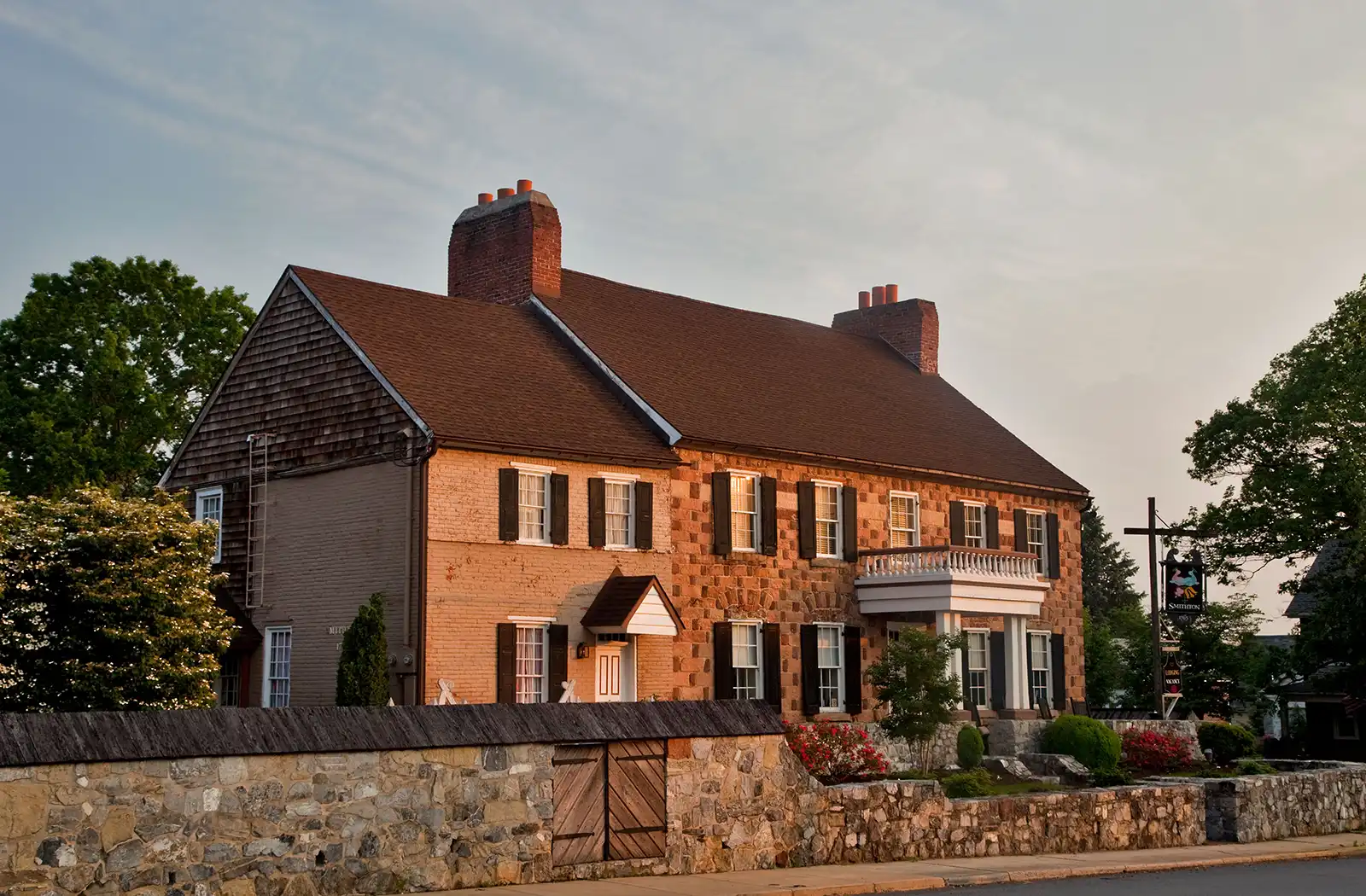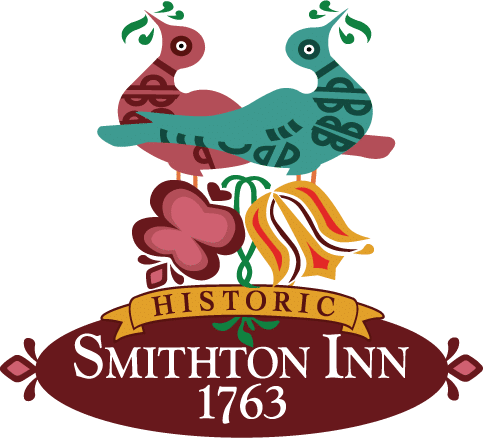
Historic Smithton Inn a History
Step into the rich history of our Lancaster bed and breakfast. Built in 1763, the inn blends historic architecture with modern comforts, offering a unique and memorable stay in Amish Country.
Our Inn
One-of-a-Kind Historic Lancaster PA Bed and Breakfast
Looking for a Bed and Breakfast in Ephrata PA? The Historic Smithton Inn Bed and Breakfast Ephrata PA is the perfect retreat for luxurious guest accommodations steeped with historic charm and casual elegance. Our B&B is located in Ephrata, PA, the heart of Amish Country, so you’ll be surrounded by attractions like Amish farmland, museums, theaters and more. We have a beautiful garden with an outdoor fire pit where you can relax after your long day of exploring. And we offer complimentary breakfast every morning!
Stay the night at the Historic Smithton Inn Bed and Breakfast Ephrata PA to escape from it all. Our rooms are spacious and comfortable, each with its own unique character, and designed with your comfort in mind. We offer a variety of modern amenities, including free Wi-Fi, Internet TV, fireplaces, private bathrooms with Jacuzzi tubs and farm-to-table breakfast. You can even enjoy live music and wine tastings in our on-site wine bar.
Choose a spacious suite with king-size bed and view of our lovely gardens or a private cottage with private entrance and sun porch! Make your reservation at our Ephrata PA Bed and Breakfast today! You won’t regret it. We’re sure that once you visit us, we’ll become your favorite place to stay when visiting Lancaster County PA. Book your quiet getaway now before all the rooms are booked up!
Inn History
18th century Henry Miller House & Tavern
The Smithton Inn is a historic country inn in the northern part of Lancaster County, Pennsylvania. It occupies the 18th century Henry Miller House.
Henry Miller opened an inn and tavern at this location in the early 1750s. He and his wife Clara were members (householders) of the Ephrata Cloister, an unprecedented Protestant monastic society. Well known throughout the colonial world, these people, who called themselves Seventh Day Baptists, built a cloister of medieval German buildings that survive today as a museum operated by the Pennsylvania Historical and Museum Commission.
Henry Miller Excluded From The Chapel He Helped Build
The Cloister was founded by Johann Conrad Beissel, a former Brethren member who left them to begin a new religious experiment in communal living near the village of Ephrata. Over the years, it became a thriving community that garnered many other Brethren who also left their congregations to join Beissel. Members were primarily vegetarians who also practiced celibacy. The colony was very autonomous. It had orchards, gardens, grain fields, the resources to manufacture clothing from flax, a sawmill, gristmill, paper mill, and a printing press.
Henry Miller was a prosperous man of practical affairs. He contributed substantially to the support of the Seventh Day Baptist society, including contributing a good deal of money and labor to the construction of a new chapel.
At the dedication service, Beissel announced in his sermon that the new building would be used as a place of worship only by the celibate members of the society and that the ‘householders,” married people like Henry Miller, would be excluded.
Although he resented Beissel’s rebuff, Henry Miller maintained his association with the Ephrata Cloister. In 1748, to settle the rift, the Cloister gave Miller 100 acres of land to which they, the society, had no clear title.
Henry Miller Died In 1757, Leaving His Tavern To His Son, Henry Miller II
In 1762, Henry Jr. and his wife Susana replaced his father’s ‘primitive structure’ with a large stone building. It stood on a hill that overlooked the Cloister and was on the main road to Scranton and points north. In 1763, Henry Miller Jr. opened his new inn and tavern to travelers and those who came to visit the now-famous Cloister.
A traveler’s diary noted that Henry Miller and his wife kept a good and proper house that would not offend a lady. Limits were imposed on how many could be lodged in one room or might sleep in one bed. The food was said to be uncommonly good.
When many of the wounded from the Battle of Brandywine were brought to the Ephrata Cloister for treatment, Henry and Susana volunteered their assistance. Things went poorly for the wounded men. Many of those who did not succumb to their wounds lost their lives in an epidemic that at the time was called “camp fever”.
Henry Miller shared their sad fate, leaving the inn to his son, Henry III.
The Miller Family & Future
A public Place Until the Civil War
From 1795 to 1808, the Miller Tavern served as the polling place for the northeastern part of Lancaster County, evidence of its prominence in the community during that timeframe.
Henry III died in 1832, leaving the Inn Tavern to his son, Samuel. The Henry Miller House was operated as a public place by the Miller family until the Civil War, when it was converted into a private residence. In 1875, the South Wing was added onto the house as a Tailor Shop.
The Miller family descendants owned the property until it was sold at auction in 1979 to Alan Smith.
A History of Smithton Owners
- Heinrich And Clara Miller: approx. 1751—1757
- Henry II And Susanna Margaret Henkel Miller: 1757—1778
- Henry III And Catharine Martin Miller: 1778—1832
- Samuel Miller: 1832—1838
- Adam Miller: 1838—1848 (estate in flux)
- Maria Miller Erb & Israel Erb: 1856—1906
- Samuel D. Erb: 1906—(?)
- Carrie Erb Garber & Andrew Garber: (?)—1978
- Alan Smith & Dorothy Graybill Smith: 1979—2009
- David Gallagher & Rebecca Cesa Gallagher: 2009—2024
- Karen Franzone: February 2024—Present
Alan Smith and Dorothy Graybill-Smith Transform The Property Back to An Inn
Alan purchased the property with the intention of turning it back into an inn. He made major structural and aesthetic renovations to bring the property back to life, including the addition of closets, bathrooms and a kitchen. The front façade of the inn was also changed. A wrap-around front porch was replaced with a portico and the two stone walls were built by local artisans. Alan’s appreciation for art and history are evident throughout his renovations, tying the property back to its Cloister roots. Traditional construction methods and materials were used, the ‘Cloister Doves’ were incorporated into the west wing structure and the stone wall design & wood cap matches the Cloister’s.
In the 30 years that Alan Smith and Dorothy Graybill-Smith owned and ran the Smithton, it was a lovely and successful inn. Alan passed away in 2004 and the inn became too much for Dorothy to handle on her own.
In 2009, David And Rebecca Gallagher Purchased The Property & Do Updates
In June of 2009, David and Rebecca Gallagher purchased the property and began updating the property’s structure and décor, combining old-world charm with modern comfort.
Since the Gallagher family took over the property in 2009, many updates and enhancements have taken place. Most notably, the interior and exterior of the property were meticulously restored to their former glory. The living room was converted into a wine bar and with that the parking lot was expanded and a charming courtyard was added to the Main Street side of the property. The small pond in the back garden was also converted into a cozy sunken fire pit. And keeping in touch with the needs of today’s traveling public, some modern features were incorporated in recent years. including 43+ inch flat screen Smart TVs, robust & reliable WiFi throughout the property and an EV charging station for guests driving electric vehicles.
The Miller Family & Future
Undoubtedly, the Historic Smithton Inn is a lovely building with a fascinating history. Visitors to this early stone house are ideally situated to take in Lancaster County’s largest farmers market (The Green Dragon), the Ephrata Cloister, the Pennsylvania Farm Museum, one of the East Coast’s great antique markets (Adamstown), and the historic town of Lititz. Ephrata is central to the 19th-century farms of the plain people, the Old Order Mennonite and Amish, who pursue their daily activities as their forbearers did a hundred years ago. This area of Lancaster County, unspoiled by commercial tourist attractions, is almost a city of tiny farms; a picturesque anachronism in today’s world of “big everything”.

This is a title
Lorem ipsum dolor sit amet, dolor erat ac accumsan nulla, iaculis magna neque amet convallis. Id donec litora nullam praesent, orci velit morbi eget enim, dui amet nulla tempus mauris. Velit nulla eu volutpat, eget urna amet massa. Enim vestibulum nunc massa, erat vel vestibulum aenean, lacus elit mauris dolor eget, quam vestibulum ipsum non. Tenetur lacinia luctus phasellus, penatibus nunc mauris nulla, volutpat turpis sem ipsum iaculis, sed accumsan velit in ut.
We found this inn on our route home from the south, and what a special treat! This Inn was built in the 1700's and had such beauty and charm. The bed was so lovely, the room very clean, and there was a sweet fireplace that we used with provided wood. So lovely on a bitter cold winters night. The breakfast was delicious and it was nice chatting with the owner. Highly recommend staying here!
— Marilee K
